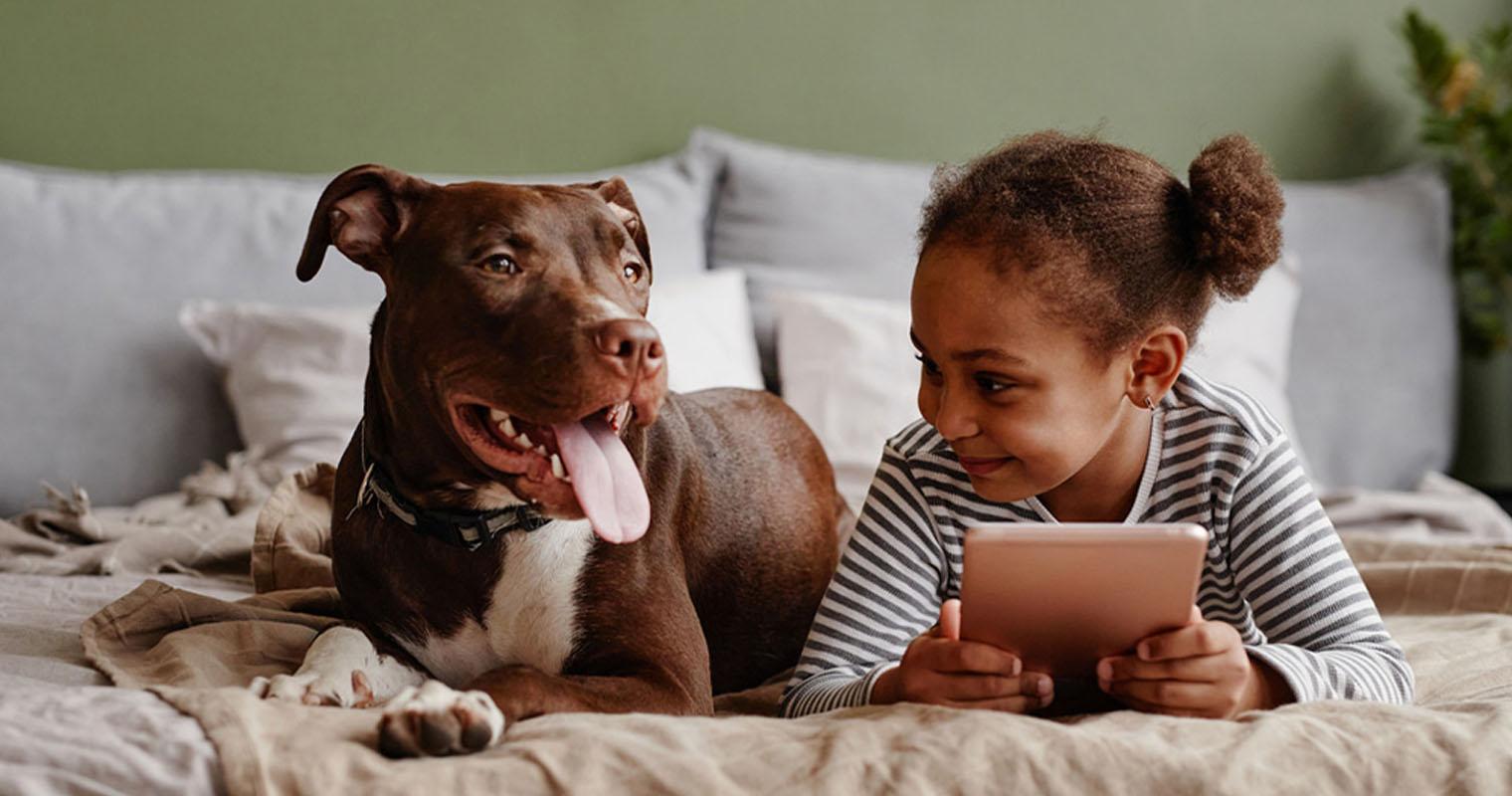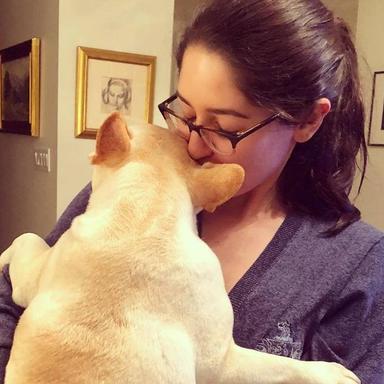Why Are Pit Bulls Called Nanny Dogs?
From the richest to the poorest and everything in between, in America, the Pit Bull was the dog for kids.
From the richest to the poorest and everything in between, in America, the Pit Bull was the dog for kids.
by Julie Zeilinger, | July 7, 2023

SeventyFour / iStock
Despite their (unfair) reputation for being dangerous, Pit Bulls were once considered some of the most beloved dogs in the United States and England. During the first part of the 20th century, families seeking dogs to keep them safe preferred Pit Bulls because they were considered highly trustworthy, protective, and loyal.
But while Pit Bulls have been referred to as “nanny dogs,” they weren’t originally bred to care for children or ever officially classified as such. Like many working dogs, Pit Bulls were originally bred and trained for hunting. So, where did the nanny dog nickname come from?
A nanny dog is a dog that is great with children — gentle, forgiving, affectionate, and watchful. Although there is no official “nanny dog” designation, certain dog breeds are often referred to as such because of their temperament around children. When properly trained and socialized from a young age, Pit Bulls make excellent “nanny dogs” or “babysitter dogs.” Pit Bulls love their people, no matter their age, and have a zest for life and play that children especially can appreciate.
Of course, no dog (of any breed) should actually be left completely alone to care for a child. Children under five are the top victim of dog bites, usually not out of aggression but due to dogs showing their boundaries (dog moms bite their puppies to correct their behavior).
Pit Bulls weren’t originally bred for nanny dogs. Many Pit Bull breeds were bred for hunting in 19th century England, Scotland, and Ireland or, in the case of American Pit Bull Terriers in the late 19th century, for fighting (which, though still abusive, wasn’t nearly as brutal at the time as it is now).
It’s important to clarify what the term “Pit Bull” actually means. A “Pit Bull” is not actually a distinct breed but rather an umbrella term that refers to a number of different Pit Bull type breeds, including the American Pit Bull Terrier, American Staffordshire Terrier, Staffordshire Bull Terrier, American Bully Dog, and many other mixed breeds.
Throughout the 19th century, Pit Bulls were increasingly bred as pets — predominately for families in the working class. This was the time around which Pit Bulls began to be recognized for their “nanny dog” qualities which made them ideal in homes with children. In the first part of the 20th century, Pit Bulls were so popular that they were often featured in the media, including in the “Our Gang/Little Rascals” films and the Buster Brown comic strips. Famous figures — including Theodore Roosevelt, Helen Keller, Thomas Edison, and Fred Astaire — were Pit Bull owners and supporters during that time. During WWI and WWII, Pit Bulls were even used in advertisements as patriotic symbols. And in the 70s, the Staffordshire Bull Terrier Club described the breed’s love of children, referring to them as ‘nursemaid dogs.’
But Pit Bulls began to be vilified in the second half of the 20th century in no small part due to their unfortunate surge in dog fighting rings, which led irresponsible breeders to mistreat them to induce vicious qualities.
The media generally also has a long history of vilifying certain dog breeds to foment fear and sell sensationalized stories. It’s a phenomenon hardly limited to Pit Bulls; before Pit Bulls, Rottweilers were demonized, and before Rottweilers, Dobermans were targeted. Before Dobermans, German Shepherds were villainized. Certain breeds — breeds that we now rightfully consider safe — have long been deemed too vicious and unpredictable to be around people.
Like any other breed, Pit Bulls are safe around children as long as an adult is observing them. Pit Bulls may behave aggressively when stressed — again, like any other dog — especially if they haven’t had the right kind of training or care. Small children should never be left alone and unsupervised with any dog. Proper training and socialization are important for any breed.
While there is no evidence that children were ever left completely alone in the care of Pit Bulls, what made them suitable in homes with children is because of their adaptable nature. Pit Bulls have an incredibly protective instinct, which makes them perfect for looking after children in their families. These breeds are also called “velcro dogs” because they always want to be around their people. They are also empathetic and able to detect distress and offer comfort — a great trait in any babysitter — in the form of snuggling or licking their humans.
Perhaps the biggest myth surrounding Pit Bulls is that they frequently attack humans. In reality, Pit Bull attacks on humans are rare. According to the Centers for Disease Control and Prevention, out of the approximately 4.5 million dog bites that occur in the United States each year, Pit Bulls cause only a small percentage.
Though Pit Bulls are not naturally human or animal aggressive, there are myths out there that they are. In fact, in 2012, 86.8% of American Pit Bull Terriers passed tests that measured their stability, aggressiveness, friendliness, and protectiveness. As a point of comparison, 85.2% of Golden Retrievers and 80.1% of Collies — two breeds largely considered incredibly friendly — passed those tests.
Some people even believe that Pit Bulls have dangerously locking jaws, but in reality, Pit Bulls’ jaws do not lock, and they do not even have the most powerful bite among dogs (German Shepherds have that honor). There are also myths that Pit Bulls don’t feel pain, but, of course, Pit Bulls feel as much pain as any other breed.
It’s ironic that one of the most tolerant, patient, gentle kinds of dog is now portrayed as the most dangerous. And yet, an estimated one million Pit Bulls are euthanized each year; they account for 40 percent of all dogs euthanized by shelters annually.
Though good with children, Pit Bulls were bred to hunt, not to babysit children. All dogs should be supervised with children, regardless of breed.
Pit Bulls have been called “babysitters” because they are gentle around children. To read more about the history of Pit Bulls, you should read Pit Bull: The Battle Over an American Icon by Bronwen Dickey.
Pit Bulls are incredibly loyal and tolerant, which makes them suitable for families with children.
Yes, Pit Bulls are friendly with children. Like any other breed, Pit Bulls are safe around children as long as an adult is observing them.
Pit Bulls have been called “nanny dogs” because they are gentle around children and can be very tolerant of them.
While stories of the Pit Bulls friendly temperament around children inspired the myth, Pit Bulls were never actually bred to be “nanny dogs.” No child should ever be left completely alone and unsupervised with a dog of any breed.
The media has spread this misconception and Pit Bulls have also been mistreated by humans and forced into illegal dog fighting, which has perpetuated this stereotype.

Julie Zeilinger is a NYC-based writer and editor whose writing has been published in Marie Claire, Vox, HuffPost, Forbes, and other publications. She is also the author of two books: College 101: A Girl’s Guide to Freshman Year (2014) and A Little F’d Up: Why Feminism Is Not a Dirty Word (2012). She is the mom to Baloo, a two-year-old Bichpoo and foster mom to dogs via Badass Animal Rescue.